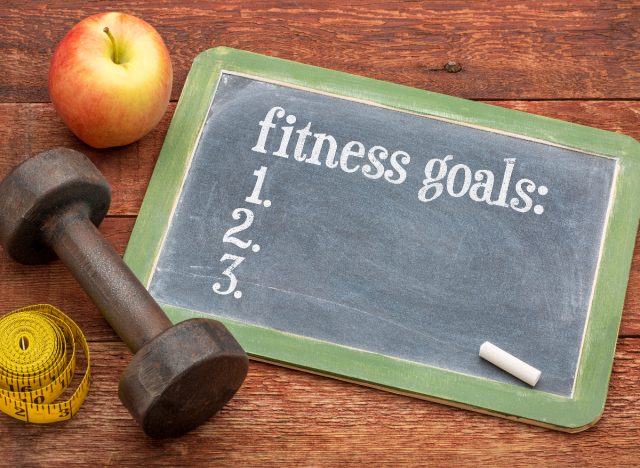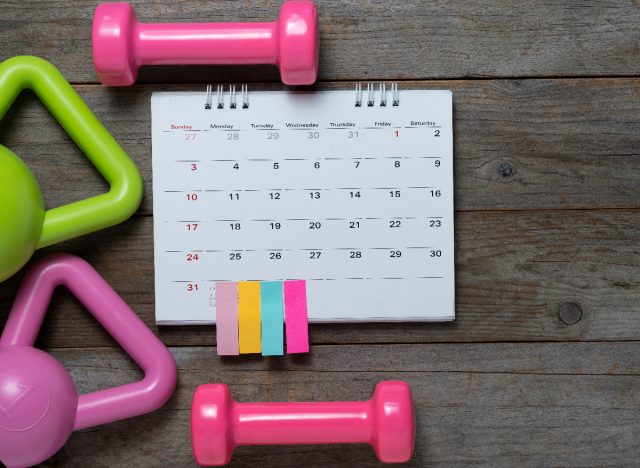Let’s be honest: We all face detours in our fitness journeys. Life happens, and sometimes, our workout routines are forced to take a back seat. Whether you’ve been out of commission for years or recently took a break to reset and recharge, the prospect of getting back into shape can seem daunting. Fortunately, we here at ETNT have your back with expert-approved tips to get in shape after a long break.
“Getting back into shape after a lengthy break can feel overwhelming when you don’t know where to start,” explains Tracie Haines-Landram, CSCS, a certified strength and conditioning specialist and nutrition coach with Barbend. “The good news is that you aren’t starting from scratch. You’re coming in with experience. While you can look to previous methods that have helped you succeed, incorporate these essential rules for a gradual and successful plan back to the best version of yourself.”
Regardless of your fitness level, Haines-Landram breaks down 12 essential rules that are sure to whip you back into tip-top shape.
Set achievable goals.

Whether it’s a target number of weekly workouts or gradually increasing your endurance, establishing clear objectives helps provide direction and motivation on your fitness journey. Start small, acknowledge your starting point, and build from there to set the stage for success.
Haines-Landram says, “We often say we want to ‘get back into shape,’ but what does that mean to you? Are you focused on how you feel, look, and perform? Be specific and honest with yourself to establish short-term and long-term goals that are achievable and motivating.”
Assess your current fitness level.

Assessing your fitness level is crucial before diving into a new routine. This step allows you to identify strengths, weaknesses, and areas for improvement. It’s not about comparing yourself to others or your past self but understanding where you are now to tailor your comeback strategy effectively.
“Start by evaluating your current fitness level to assess your goals. This can be done both qualitatively (how you feel and look) and qualitatively (how you perform),” says Haines-Landram.
Create a realistic plan.

Craft a fitness plan that suits your lifestyle and acknowledges your current commitments. You may prefer home workouts over gym sessions or vice versa. Either way, a realistic plan aligns with your schedule, making it more likely for you to stick with it.
“Develop a workout routine that aligns with your schedule and gradually increases in intensity,” Haines-Landram recommends. “A common mistake is ramping up the intensity before your body is ready, leading to burnout or injury. We remember what we ‘used to be able to do’ and assume we can hop right back into that zone.”
Be consistent.

While your progress might be slow and steady, adhering to your plan consistently over time yields significant results. Whether it’s a 20-minute workout or a longer session, making daily movement a part of your routine is crucial.
“Consistency is key. Aim for regular workouts, even if they’re shorter initially. This is more mindset training than anything. You want to create the identity that you are the kind of person who works out, and each time you work out, you reinforce that statement,” explains Haines-Landram.
Track your progress.

Track your workouts, and make note of improvements in strength or endurance. You can also document how you felt mentally and emotionally during and after your workouts.
Haines-Landram stresses, “Keep a workout journal or use apps to track your progress in and out of the gym. Focus on habits that support your goals, not just the goals themselves. For example, a calendar habit tracker where you cross off every day you work out or mark every night you get eight hours of sleep.”
Celebrate your achievements.

Whether completing a challenging workout, achieving a specific goal, or consistently sticking to your fitness plan, acknowledging and celebrating your milestones along the way reinforces positive behavior and fosters a mindset of success.
“You don’t have to wait until you feel back in shape to celebrate,” says Haines-Landram. “Acknowledge when you’re making improvements and use it as a form of positive reinforcement.”
Create accountability.

Establishing accountability adds an extra layer of support to your comeback journey. Find a workout buddy, join a fitness class, or share your goals with family and friends to help keep you on track.
“Motivation may be high when you start back into a workout routine, but we often need external support to keep us going when motivation wanes,” says Haines-Landram. “Create an accountability system to ensure you’re staying focused on your plan. Find an accountability partner to check in with weekly and share how your journeys are going. If possible, plan your workouts so that you’re signing up for a class or meeting someone.”
Prioritize nutrition.

It’s no secret that proper nutrition is critical in achieving your fitness goals. Eat a well-balanced diet based around minimally processed, whole foods that fuel your workouts and support recovery.
“Pay attention to your nutrition, focusing on balanced meals to support your workouts. For example, if your goal is to gain strength and increase muscle mass, focus on total calories and amount of protein consumed. Nutrition plans will vary depending on your goal, but it’s important to have proper nutrition fueling your goals,” explains Haines-Landram.
Meal prep.

Planning and preparing meals in advance will save you time while ensuring you have nutritious meals on hand, reducing the temptation of unhealthy choices. Plus, research links meal prepping to healthy weight management.
“Our food environments have never been more bombarded with tempting foods that steer us away from our nutrition goals,” states Haines-Landram. “Having meals planned helps fight the urge to grab whatever is easiest. We often hear about ‘meal prepping’ and think it means spending every weekend perfectly planning, cooking, and sorting your food for the week in black rectangular boxes, but meal prep doesn’t have to be so rigid. Meal prep can be as simple as making sure your grocery shopping list has all your essential ingredients for the week.”
Stay hydrated.

Proper water intake supports bodily functions, aids recovery, and ensures you perform at your best. Make hydration a non-negotiable aspect of your daily routine.
“Hydration is crucial for overall health and exercise performance, regardless of your goal,” says Haines-Landram. “The winter weather may not trigger your thirst as much as summer workouts, but we still need to stay hydrated. Incorporate a refillable water bottle into your daily routine.”
Prioritize rest and recovery.

Rest and recovery are integral parts of any fitness journey. Allow your body time to recover between workouts, ensuring quality sleep and incorporating rest days into your routine. This balanced approach prevents burnout and promotes a sustainable approach to getting back in shape.
Haines-Landram says, “Allow time for rest and recovery to prevent burnout and reduce the risk of injury. Recovery time is also when you can tune into how your body feels and assess how you feel your progress is going.”
Seek professional guidance.

Whether it’s a personal trainer, physical therapist, or registered dietitian, consider seeking professional guidance to get back in shape after a long break. Their expertise can provide personalized insights and support tailored to your unique needs and goals.
“If possible, consult with a certified fitness professional for personalized guidance. Join a group fitness challenge, in person or virtually, that aligns with your goals and provides support,” says Haines-Landram.









